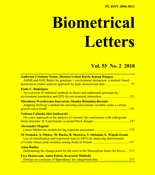
Biometrical Letters Vol. 55(2), 2018, pp. 215-232


The consequences of the growing demand for water include a significant deterioration in its quality and a drastic decline in biodiversity, which is a serious threat to the hydrological and biocenotic balance of freshwater ecosystems. A good indicator of aquatic environment quality is macrophytes. Studies on macrophytes are one of the primary elements in the ecological status assessment of surface waters, in accordance with the guidelines of the Water Framework Directive. In Poland, research on the ecological status of rivers with regard to macrophytes has been carried out since 2008, using the Macrophyte Index for Rivers (MIR), which takes into account the number and coverage of macrophyte taxa. An analysis of numbers of species that need to be indicated at a site for valid assessment of the ecosystem was conducted on the basis of studies on macrophytes from 2008–2013, at 60 sites in small lowland rivers with a sandy substrate, of which 20 sites were selected on the most diverse watercourses: the least clean (quality class V), moderate (quality class III), and the cleanest (quality class I). The results of the botanical studies served to assess the completeness of the samples (the number of species recorded at a site) used to evaluate the ecological status of a river. The proposed analyses enabled estimation of the approximate number of species required to determine the MIR for rivers in each quality class.

macrophytes, Macrophyte Index for Rivers (MIR), At Most One Change (AMOC)

